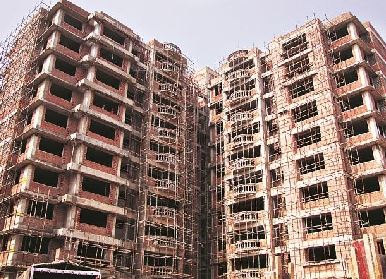
Industrial, logistics segments to drive realty growth
- जून 23, 2022
- 0
The second wave of Covid-19 has had a diverse impact in different segments of the realty estate sector in the first half of calendar year 2021. While the residential segment has seen growth, office properties have seen a hit.
Comparison of residential sales in India
Residential launches and sales have picked up sharply in H1 of 2021 as compared to the same period last year, though the second Covid wave stalled the momentum somewhat in the second quarter this year. Residential prices have witnessed some correction and they are likely to remain in that range, at least in the near term. Developers continue to offer incentives to attract homebuyers. These include selective price discounts, price protection, free furniture, EMI holidays, and easy cancellations or refunds, among others. Sustained low borrowing rates will provide an added boost to housing demand. Residential sector in APAC markets remains resilient with higher sales recorded in 2020 despite the impact of Covid-19.
Uptick in higher-priced homes is higher than lower-priced ones in recent months.
There are a multitude of factors contributing to this phenomenon. On the customer side, the pandemic ensured that people spent an unprecedented amount of time in their homes with families. The expectation from home as a space underwent a significant change. Larger houses, study areas and gardening spaces are some of the aspects that have emerged as new needs, post pandemic. Market rates are still lower than the old highs.
Outlook for office leasing in H2 this year
Gross leasing fell by 16.9 per cent on a Quarter on Quarter basis in the top eight cities, although rentals remained largely stable. And, pre-leasing of under construction properties witnessed a surge in cities such as Hyderabad and Chennai. The biggest factor that is going to infuse optimism is the vaccination drive that is set to pick up pace.
Shopping malls are likely to benefit from improvement in consumer demand as vaccination picks up, the employment scenario strengthens, and consumers witness an improvement in purchasing power gradually. Footfalls at malls are set to increase with landlords and tenants implementing health and safety protocols and ensuring social distancing. The third wave, if there is one, is likely to have a mild impact on the real estate sector.
Some of the big changes in Indian real estate during the pandemic.
It has seen a rise in focus on industrial and logistics as well as data centres. It is now acknowledged that these asset classes are likely to drive growth in the real estate sector over the medium to long term. They are increasingly attracting long-term institutional capital from large and global players. Also policies such as PLI for sectors such as electronics, IT, and Pharma are likely to drive demand for Grade A warehouses.
रियल्टी ग्रोथ को बढ़ावा देने के लिए इंडस्ट्रियल, लॉजिस्टिक्स सेगमेंट
कैलेंडर वर्ष 2021 की पहली छमाही में कोविड -19 की दूसरी लहर का रियल्टी एस्टेट क्षेत्र के विभिन्न क्षेत्रों में विविध प्रभाव पड़ा है। जबकि आवासीय खंड में वृद्धि देखी गई है, कार्यालय की संपत्तियों में एक कमजोरी देखी गई है।
भारत में आवासीय बिक्री की समीक्षा
पिछले साल की इसी अवधि की तुलना में 2021 की पहली छमाही में आवासीय लॉन्च और बिक्री में तेजी से वृद्धि हुई है, हालांकि दूसरी कोविड लहर ने इस साल दूसरी तिमाही में गति को कुछ हद तक रोक दिया। आवासीय कीमतों में कुछ सुधार देखा गया है और वे कम से कम निकट भविश्य में उसी सीमा में रहने की संभावना है। डेवलपर्स होमबॉयर्स को आकर्षित करने के लिए प्रोत्साहन की पेशकश जारी रखते हैं। इनमें सेलेक्टिव प्राइस डिस्काउंट, प्राइस प्रोटेक्शन, फ्री फर्नीचर, ईएमआई हॉलिडे और आसान कैंसिलेशन या रिफंड आदि शामिल हैं। निरंतर कम उधारी दरों से आवास की मांग को अतिरिक्त बढ़ावा मिलेगा। APAC बाजारों में आवासीय क्षेत्र कोविड -19 के प्रभाव के बावजूद 2020 में दर्ज की गई उच्च बिक्री के साथ लचीला बना हुआ है।
हाल के महीनों में उच्च कीमत वाले घरों की मांग में बढ़ोतरी कम कीमत वाले घरों की तुलना में अधिक है।
इसमें योगदान देने वाले कई कारक हैं। ग्राहक पक्ष पर, महामारी ने सुनिश्चित किया कि लोग अपने घरों में परिवारों के साथ में अभूतपूर्व समय बिताएं। एक स्थान के रूप में घर की जरूरत में एक महत्वपूर्ण परिवर्तन आया। बड़े घर, अध्ययन क्षेत्र और बागवानी स्थान कुछ ऐसे पहलू हैं जो महामारी के बाद नई जरूरतों के रूप में उभरे हैं। बाजार भाव अभी भी पुरानी ऊंचाई से कम है।
इस साल H2 में ऑफिस लीजिंग के लिए
शीर्ष आठ शहरों में तिमाही से तिमाही के आधार पर सकल पट्टे में 16.9 प्रतिशत की गिरावट आई, हालांकि किराया काफी हद तक स्थिर रहा और, निर्माणाधीन संपत्तियों की पूर्व-पट्टे पर हैदराबाद और चेन्नई जैसे शहरों में वृद्धि देखी गई। आशावाद को बढ़ावा देने वाला सबसे बड़ा कारक टीकाकरण अभियान है जो गति पकड़ने के लिए तैयार है।
भारत में मॉल की स्थिति
शॉपिंग मॉल्स को उपभोक्ता मांग में सुधार से लाभ होने की संभावना है क्योंकि टीकाकरण में तेजी की गई है, रोजगार परिदृश्य मजबूत हो रहा है, और उपभोक्ताओं की क्रय शक्ति में धीरे-धीरे सुधार हो रहा है। स्वास्थ्य और सुरक्षा प्रोटोकॉल को लागू करने और सामाजिक दूरी सुनिश्चित करने के लिए जमींदारों और किरायेदारों के साथ मॉल में फुटफॉल बढ़ने के लिए तैयार हैं।
महामारी के दौरान भारतीय रियल एस्टेट में कुछ बड़े बदलाव
इसने औद्योगिक और रसद के साथ-साथ डेटा केंद्रों पर ध्यान केंद्रित किया है। अब यह स्वीकार किया गया है कि इन परिसंपत्ति वर्गों से मध्यम से लंबी अवधि में रियल एस्टेट क्षेत्र में विकास की संभावना है। वे बड़े और वैश्विक खिलाड़ियों से दीर्घकालिक संस्थागत पूंजी को तेजी से आकर्षित कर रहे हैं। साथ ही इलेक्ट्रॉनिक्स, आईटी और फार्मा जैसे क्षेत्रों के लिए पीएलआई जैसी नीतियों से ग्रेड ए गोदामों की मांग बढ़ने की संभावना है।
































































